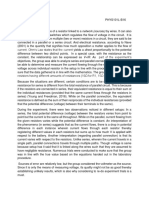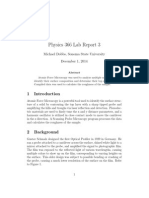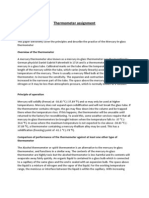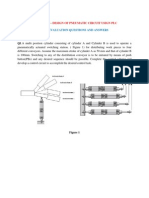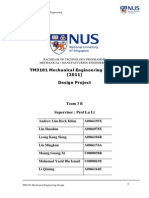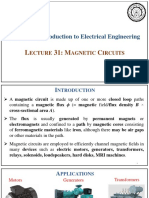Wave Guides
Wave Guides
Uploaded by
Eric John Dela CruzCopyright:
Available Formats
Wave Guides
Wave Guides
Uploaded by
Eric John Dela CruzCopyright
Available Formats
Share this document
Did you find this document useful?
Is this content inappropriate?
Copyright:
Available Formats
Wave Guides
Wave Guides
Uploaded by
Eric John Dela CruzCopyright:
Available Formats
WAVEGUIDES
Submitted to: Engr. Eriberto Hallarsis
Submitted by: Celi Liana A. Cruz Edniel A. Dejada
February 1, 2012
HISTORY
The first structure for guiding waves was proposed by J. J. Thomson in 1893, and was first experimentally tested by Oliver Lodge in 1894. The first mathematical analysis of electromagnetic waves in a metal cylinder was performed by Lord Rayleigh in 1897. For sound waves, Lord Rayleigh published a full mathematical analysis of propagation modes in his seminal work, The Theory of Sound. The study of dielectric waveguides began as early as the 1920s, by several people, most famous of which are Rayleigh, Sommerfeld and Debye. Optical fiber began to receive special attention in the 1960s due to its importance to the communications industry.
WAVEGUIDES Waveguide is a device that constrains or guides the propagation of electromagnetic waves along a path defined by the physical construction of the guide. It can be used to transmit power or signals in the form of waves while minimizing power loss.
Most waveguides are made of aluminum, brass or copper. Waveguides are hollow metal pipes and may have either circular or rectangular cross sections. Common waveguide shapes are rectangular, circular, and ridged. Waveguide has a number of advantages over coax, microstrip and stripline. It is completely shielded,it can transmit extremely high peak powers and it has very low loss at microwave frequencies. Most waveguides are of the rectangular variety. It is the size of the waveguide that determines its operating frequency range.
The width of the waveguide is designated a, and the height is designated b. The frequency of operation is determined by the a dimension. This dimension is usually made equal to one-half the wavelength at the lowest frequency of operation. This frequency is known as the waveguide cutoff frequency. At the cutoff frequency and below, the waveguide will not transmit energy. At frequencies above the cutoff frequency, the waveguide will propagate electromagnetic energy. The waveguide is essentially a high- pass filter with a cut off frequency equal to
fco = 3002a
Problem: A waveguide has an a width of 0.8 in. What is the cutoff?
PROPAGATION MODES IN WAVEGUIDE
The pattern of the electromagnetic fields within a waveguide takes many forms. Each form is called an operating mode. Either the H or E field must be perpendicular to the direction of propagation of the wave. Modes are classified as either transverse electric (TE) or transverse magnetic (TM). TE mode - the E field exists across the guide and no E lines extend lengthwise along the guide. TM mode the H lines form loops in planes perpendicular to the walls of the guide, and no part of an H line is lengthwise along the guide.
Waveguide (TE) transverse electric and (TM) transverse magnetic modes.
All electromagnetic waves consist of electric and magnetic fields propagating in the same direction of travel, but perpendicular to each other. Along the length of a normal transmission line, both electric and magnetic fields are perpendicular (transverse) to the direction of wave travel. This is known as the principal mode, or TEM (Transverse Electric and Magnetic) mode. This mode of wave propagation can exist only where there are two conductors, and it is the dominant mode of wave propagation where the cross-sectional dimensions of the transmission line are small compared to the wavelength of the signal.
At microwave signal frequencies (between 100 MHz and 300 GHz), twoconductor transmission lines of any substantial length operating in standard TEM mode become impractical. Lines small enough in cross-sectional dimension to maintain TEM mode signal propagation for microwave signals tend to have low voltage ratings, and suffer from large, parasitic power losses due to conductor skin and dielectric effects. Fortunately, though, at these short wavelengths there exist other modes of propagation that are not as lossy, if a
conductive tube is used rather than two parallel conductors. It is at these high frequencies that waveguides become practical. The mode with the lowest cutoff frequency is termed the dominant mode of the guide. It is usual to choose the size of the guide such that only this one mode can exist in the frequency band of operation. In rectangular and circular (hollow pipe) waveguides, the dominant modes are designated the TE1,0 mode and TE1,1 modes respectively. The first number indicates the number of half-wave patterns of transverse lines that exists along the short dimension of the guide through the center of the cross-section . The second number indicates the number of transverse half-wave patterns that exist along the long dimension of the guide through the center of the cross-section.
TE1,0 mode of a rectangular hollow metallic waveguide.
TE1,1 mode of a circular hollow metallic waveguide
Applications Waveguides can be constructed to carry waves over a wide portion of the electromagnetic spectrum, but are especially useful in the microwave and optical frequency ranges. Waveguides are used for transferring both power and communication signals, usually for short distances. The main advantage of waveguides in comparison to other transmission lines is in high power applications. The uses of waveguides for transmitting signals were known even before the term was coined. The phenomenon of sound waves guided through a taut wire have been known for a long time, as well as sound through a hollow pipe such as a cave or medical stethoscope. Other uses of waveguides are in transmitting power between the components of a system such as radio, radar or optical devices. Waveguides are the fundamental principle of guided wave testing (GWT), one of the many methods of nondestructive evaluation. Specific examples: Optical fibers transmit light and signals for long distances and with a high signal rate. In a microwave oven a waveguide leads power from the magnetron where waves are formed to the cooking chamber. In a radar, a waveguide leads waves to the antenna, where their impedance needs to be matched for efficient power transmission. A waveguide called stripline can be created on a printed circuit board, and is used to transmit microwave signals on the board. This type of waveguide is very cheap to manufacture and has small dimensions which fit inside printed circuit boards. Waveguides are used in scientific instruments to measure optical, acoustic and elastic properties of materials and objects. The waveguide can be put in contact with the specimen (as in a Medical ultrasonography), in which case the waveguide ensures that the power of the testing wave is conserved, or the specimen may be put inside the waveguide (as in a dielectric constant measurement), so that smaller objects can be tested and the accuracy is better.
You might also like
- Disney - Ice Age - The Movie Novel (KT) PDFDocument125 pagesDisney - Ice Age - The Movie Novel (KT) PDFMoyeen Uddin Hasan100% (1)
- Experiment 9 Analysis and Conclusion PDFDocument5 pagesExperiment 9 Analysis and Conclusion PDFQuirino Arzadon IV50% (2)
- Sound Attenuation in Lined Rectangular Ducts With Flow and Its Application To The Reduction of Aircraft Engine NoiseDocument16 pagesSound Attenuation in Lined Rectangular Ducts With Flow and Its Application To The Reduction of Aircraft Engine Noisecarbon89No ratings yet
- Cheat Sheet Biomedical Instrumentation ExamDocument1 pageCheat Sheet Biomedical Instrumentation Examdeemz00% (1)
- In Electrical Electronic MeasurementDocument29 pagesIn Electrical Electronic Measurementsiddhartha bharadwajNo ratings yet
- Models - Plasma.drift Diffusion TutorialDocument14 pagesModels - Plasma.drift Diffusion TutorialbkmmizanNo ratings yet
- AFM Lab ReportDocument14 pagesAFM Lab Reportsmoothieboy0% (1)
- 1Document68 pages1Ujwal JaiswalNo ratings yet
- Wave GuideDocument6 pagesWave GuideNaeemrindNo ratings yet
- Experiment No 2Document5 pagesExperiment No 2shweta suryawanshi100% (1)
- Arzel Zoning Bypass CalculatorDocument6 pagesArzel Zoning Bypass CalculatorVíctor RojasNo ratings yet
- 2011 06 13-DI-PER8-Acoustic Insulation Catalogue-Rev 01Document12 pages2011 06 13-DI-PER8-Acoustic Insulation Catalogue-Rev 01Tien PhamNo ratings yet
- Plasma Application Library ManualDocument404 pagesPlasma Application Library ManualRanjithPerumalNo ratings yet
- HVAC Eng - Mohamed MobarkDocument152 pagesHVAC Eng - Mohamed MobarkMUBASHIRNo ratings yet
- Power Capacity HVAC CalculationDocument12 pagesPower Capacity HVAC CalculationEdNo ratings yet
- Thermometer AssignmentDocument3 pagesThermometer AssignmentJay Kim100% (2)
- Minutes of Meeting - TCS Interface Coordination 001Document6 pagesMinutes of Meeting - TCS Interface Coordination 001Zulkarnain Dahalan0% (1)
- FEA CEP Report: ANSYS SoftwareDocument10 pagesFEA CEP Report: ANSYS SoftwareAli Raza100% (1)
- Frictional Losses in Circular PipeDocument5 pagesFrictional Losses in Circular PipeVrushiket PatilNo ratings yet
- Heat Transfer Through The Lagged PipeDocument6 pagesHeat Transfer Through The Lagged PipeDhananjay Kadam100% (1)
- Chapter 4Document6 pagesChapter 4Peth alambatinNo ratings yet
- Lamb WavesDocument7 pagesLamb WavesCesar VasquesNo ratings yet
- Introduction To Electro-OpticsDocument34 pagesIntroduction To Electro-OpticspraadiitaaNo ratings yet
- Bubble PowerDocument21 pagesBubble PowerMaleeha Tabassum KhanNo ratings yet
- Avalanche Transit Time DevicesDocument13 pagesAvalanche Transit Time Devicesuma_maduraiNo ratings yet
- Mockup T510Document5 pagesMockup T510ardiansyah marwanNo ratings yet
- 2176 - Cap - 3 Thermal-Electrical AnalogyDocument17 pages2176 - Cap - 3 Thermal-Electrical AnalogyAdityaNo ratings yet
- Chapter 7magnetic CircuitDocument25 pagesChapter 7magnetic CircuitAndrey VieiraNo ratings yet
- UNIT 5 Superconductor... NanomaterialsDocument10 pagesUNIT 5 Superconductor... Nanomaterialssantoshdevi9758100% (1)
- Sample Question Paper Thermal EngineeringDocument5 pagesSample Question Paper Thermal Engineeringरितेश हरोडेNo ratings yet
- Acoustic Prop Model Thru MatlabDocument75 pagesAcoustic Prop Model Thru MatlabArvind MuraliNo ratings yet
- Synopsis On Mathematical Model of Microwave TransmissionDocument3 pagesSynopsis On Mathematical Model of Microwave TransmissionHaresh Verma100% (1)
- Si Solar Cell 1D: Created in COMSOL Multiphysics 5.2aDocument14 pagesSi Solar Cell 1D: Created in COMSOL Multiphysics 5.2aHarold PuinNo ratings yet
- MEMS With Microactuators - by SayyanDocument17 pagesMEMS With Microactuators - by SayyansayyanNo ratings yet
- ME3112-1 Lab Vibration MeasurementDocument8 pagesME3112-1 Lab Vibration MeasurementLinShaodunNo ratings yet
- Micro ActuatorsDocument10 pagesMicro ActuatorsEyad A. FeilatNo ratings yet
- Substrate Integrated Waveguide PaperDocument3 pagesSubstrate Integrated Waveguide PaperSabirSayedNo ratings yet
- 1 Practical Applications of Electromagnetism PDFDocument10 pages1 Practical Applications of Electromagnetism PDFChunesh BhallaNo ratings yet
- Physics at Nanoscale CH 1Document87 pagesPhysics at Nanoscale CH 1ParmodDhandaNo ratings yet
- Numbering Scheme For Two Motion Selector: Electronic Switching SystemsDocument32 pagesNumbering Scheme For Two Motion Selector: Electronic Switching SystemsVeerayya JavvajiNo ratings yet
- Lock in Amplifier Tender DocumentDocument26 pagesLock in Amplifier Tender DocumentrauolNo ratings yet
- Piezoelectricity - WikipediaDocument19 pagesPiezoelectricity - Wikipediasl540No ratings yet
- Root Locus Method 2Document33 pagesRoot Locus Method 2Umasankar ChilumuriNo ratings yet
- Sweety Home T&C Form PDFDocument4 pagesSweety Home T&C Form PDFHtin Aung KyawNo ratings yet
- Microwave Tube FINALDocument22 pagesMicrowave Tube FINALJb BascoNo ratings yet
- Characteristics of G.M.Counter by MR - CharisDocument4 pagesCharacteristics of G.M.Counter by MR - CharisCharis Israel Ancha100% (4)
- T&CDocument13 pagesT&CAbdurRahmanFNo ratings yet
- Applied Physics Lab Lab LabDocument31 pagesApplied Physics Lab Lab LabMUHAMMAD IBRAHIM KHALID CSE.Pesh - Batch 20No ratings yet
- Lecture 42 - Design of Pneumatic Circuit Usign PLC: Self Evaluation Questions and AnswersDocument5 pagesLecture 42 - Design of Pneumatic Circuit Usign PLC: Self Evaluation Questions and AnswersjtorerocNo ratings yet
- MESB 333 Lab Temperature MeasurementDocument9 pagesMESB 333 Lab Temperature Measurementhezree hilmanNo ratings yet
- TM3101 Design Project Report PDFDocument128 pagesTM3101 Design Project Report PDFMd. Mahabubul HassanNo ratings yet
- CHP 2Document9 pagesCHP 2BRIAN CLIFFNo ratings yet
- Unit 4 PPT MasterDocument57 pagesUnit 4 PPT MasterRamNo ratings yet
- Objective Type Questions Instrumentation System & Devices (IDS)Document7 pagesObjective Type Questions Instrumentation System & Devices (IDS)mail2jaleel9952No ratings yet
- Hot-Wire Anemometry of The Streamwise Vorticity On The Windward Surface of A Swept-Back CylinderDocument28 pagesHot-Wire Anemometry of The Streamwise Vorticity On The Windward Surface of A Swept-Back CylinderAndyMirzaiNo ratings yet
- Final MTech ProjectDocument30 pagesFinal MTech ProjectArunSharmaNo ratings yet
- ELL 100 Introduction To Electrical Engineering: EctureDocument43 pagesELL 100 Introduction To Electrical Engineering: EcturedeependraNo ratings yet
- RceDocument11 pagesRceAssilla SekarNo ratings yet
- Heating and Cooling of Electric MachineDocument36 pagesHeating and Cooling of Electric Machinexettrinirmal2No ratings yet
- Por Example 11Document2 pagesPor Example 11rui annNo ratings yet
- Optical and Microwave Technologies for Telecommunication NetworksFrom EverandOptical and Microwave Technologies for Telecommunication NetworksNo ratings yet
- Physics Project Final1Document15 pagesPhysics Project Final1sohamNo ratings yet
- Waveguide: Feed Line Microwave Electromagnetic Field Horn Antenna Dish AntennaDocument1 pageWaveguide: Feed Line Microwave Electromagnetic Field Horn Antenna Dish AntennaMohammad MolanzadehNo ratings yet
- Brand Preferences58 12Document58 pagesBrand Preferences58 12sathish0% (1)
- Deluge and Preaction SystemsDocument54 pagesDeluge and Preaction SystemsVuk MarovicNo ratings yet
- 3-1b Viruses and The Hershey-Chase ExperimentDocument2 pages3-1b Viruses and The Hershey-Chase Experiment7pc9pm27p9No ratings yet
- Us3873779 PDFDocument12 pagesUs3873779 PDFAlex PerezNo ratings yet
- Valve Test ReportDocument3 pagesValve Test ReportHery MukhlisNo ratings yet
- Proposal For Carpark (Revised)Document6 pagesProposal For Carpark (Revised)Ong George SammyNo ratings yet
- Obtaining 2 Degrees of Freedom Using SVM For Upper Arm Neural ExoskeletonDocument7 pagesObtaining 2 Degrees of Freedom Using SVM For Upper Arm Neural ExoskeletonMahajan AbhishekNo ratings yet
- User Manual OPDocument64 pagesUser Manual OPDavid SanjayaNo ratings yet
- CB2500 Information Management ChecklistDocument4 pagesCB2500 Information Management Checklistsiu chun chanNo ratings yet
- CH 4 Income From House PropertyDocument89 pagesCH 4 Income From House PropertyPratyashNo ratings yet
- Ebooks File (Ebook PDF) Lehne's Pharmacotherapeutics For Advanced Practice Providers All ChaptersDocument39 pagesEbooks File (Ebook PDF) Lehne's Pharmacotherapeutics For Advanced Practice Providers All Chapterssanchesheay100% (4)
- Deployment of Application On Wls11gDocument15 pagesDeployment of Application On Wls11gsopan sonarNo ratings yet
- Agricultural ProductionDocument118 pagesAgricultural ProductionZack DiazNo ratings yet
- House ValuationDocument6 pagesHouse ValuationOD HillsNo ratings yet
- Mass Communication and Journalism Paper - Iii: DigdarshanDocument15 pagesMass Communication and Journalism Paper - Iii: DigdarshanriniNo ratings yet
- Flores Chapter 7-8Document65 pagesFlores Chapter 7-8Reinzo GallegoNo ratings yet
- Tax Invoice Cum Delivery Challan: JPR/2223/4108 521464681784 11-Feb-23Document4 pagesTax Invoice Cum Delivery Challan: JPR/2223/4108 521464681784 11-Feb-23Lazzieey RahulNo ratings yet
- Protection Motivation Theory (PMT) : Sruti Ahmed COMM634Document12 pagesProtection Motivation Theory (PMT) : Sruti Ahmed COMM634Sruty AhmedNo ratings yet
- Pa MetersDocument3 pagesPa MetersmageroteNo ratings yet
- 01 - Nokia RNC ArchitectureDocument34 pages01 - Nokia RNC ArchitectureManish AgarwalNo ratings yet
- Aggregation & SedimentationDocument11 pagesAggregation & SedimentationreyzaNo ratings yet
- ALFA 5KVA Service Manual 201509ADocument46 pagesALFA 5KVA Service Manual 201509Asaif ul noorNo ratings yet
- Key Programming EquipmentDocument44 pagesKey Programming EquipmentТоме Тошев Туди100% (1)
- Environmental PolicyDocument1 pageEnvironmental PolicysimoneNo ratings yet
- Theories of AgingDocument10 pagesTheories of AgingCrystal PughNo ratings yet
- HistoryDocument3 pagesHistoryRaylightNo ratings yet
- KYC (Know Your Customer) Policy & Anti Money Laundering MeasuresDocument10 pagesKYC (Know Your Customer) Policy & Anti Money Laundering MeasuresManvi PareekNo ratings yet

